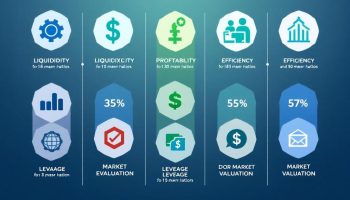
Understanding Risk Control Self-Assessment (RCSA)
Risk control self-assessment (RCSA) empowers organizations to proactively identify, evaluate, and prioritize risks across financial, operational, compliance, and reputational domains. A comprehensive risk control self-assessment framework examines critical business processes, enabling teams to take ownership of risk management and safeguard organizational objectives before potential issues escalate.
Key Takeaways
- RCSA serves as a proactive internal health check for identifying and mitigating organizational risks
- The process involves mapping critical processes and assessing their potential vulnerabilities
- Effective RCSA requires collaboration across different departments and stakeholders
- Regular reassessment ensures the risk management framework remains relevant and adaptive
- Technology and automation tools can significantly enhance the RCSA implementation process
You’ll find RCSA creates a structured approach to understanding what could go wrong in your business operations. This assessment technique puts the power of risk identification directly in the hands of your operational teams. Instead of waiting for external auditors to discover issues, your staff becomes the first line of defense against potential threats.
The benefits extend beyond basic compliance. When you implement a robust RCSA program, you create transparency around control effectiveness and establish clear accountability for risk management across your organization.
Implementation Steps
Most successful implementations follow a step-by-step approach:
- Define your scope and objectives.
- Map out key processes and identify inherent risks.
- Assess existing controls and determine residual risk levels.
- Develop action plans to address any gaps.
Regular monitoring keeps your risk management strategy current and effective. Consider using specialized risk assessment software to streamline data collection and analysis. These tools help standardize your approach and provide valuable visualization capabilities for reporting to stakeholders.
The end result? A more resilient organization with improved decision-making capabilities and stronger safeguards against potential threats.
“Risk Control Self-Assessment is not just a protocol; it’s the heartbeat of an organization’s proactive approach to safeguarding its objectives by identifying and mitigating risks before they evolve into crises. By fostering collaboration and leveraging technology, organizations can turn vulnerability assessments into dynamic strategies, ensuring resilience in a rapidly changing landscape.”
Understanding RCSA
Risk Control Self-Assessment (RCSA) is a systematic process for identifying, evaluating, and prioritizing risks and controls within your organization. It acts as a proactive internal health check for your business operations, helping you safeguard organizational objectives and improve resilience against potential threats. An effective risk control self-assessment example involves examining financial, operational, compliance, and reputational risks across all departments.
You’ll find RCSA particularly valuable when implementing significant changes in your organization. By conducting a thorough risk control self-assessment example exercise, you can identify potential problems before they escalate into costly issues. This process empowers your team to take ownership of risk management rather than relying solely on external auditors or risk specialists.
Core Components of an Effective RCSA
The foundation of any risk control self-assessment example begins with identifying your business objectives and critical processes. This mapping exercise helps focus your risk management efforts on what truly matters. Here’s what a typical RCSA framework includes:
- Risk identification across all operational areas
- Assessment of existing control effectiveness
- Gap analysis between current and desired risk levels
- Action planning to address identified weaknesses
- Ongoing monitoring and reporting mechanisms
This table illustrates a basic risk control self-assessment example format:
| Process | Risk Description | Inherent Risk Rating | Existing Controls | Control Effectiveness | Residual Risk | Action Required |
|---|---|---|---|---|---|---|
| Accounts Payable | Unauthorized payments | High | Dual authorization | Partially Effective | Medium | Implement automated verification |
| IT Systems | Data breach | Critical | Encryption, firewalls | Effective | Medium | None |
| Hiring Process | Compliance violation | Medium | Training program | Ineffective | High | Develop new compliance checks |
When planning effective risk responses, your RCSA results provide critical insights. The risk control self-assessment example above demonstrates how you can systematically evaluate each process area. This structured approach ensures you don’t overlook critical vulnerabilities that could threaten your disaster recovery plan.
Remember that RCSA isn’t a one-time event but rather an ongoing cycle of improvement. Regular assessments help maintain your risk control self-assessment example framework’s relevance as your business environment evolves. By integrating RCSA into your operational risk management practices, you’ll create a more resilient organization capable of anticipating and mitigating potential threats before they impact your bottom line.
Organizations that implement a proactive risk assessment strategy are 50% more likely to achieve their business objectives.
forbes.com
Core Components of RCSA
A well-structured Risk Control Self Assessment (RCSA) framework contains essential elements that help your organization identify, assess, and manage risks effectively. You’ll need to incorporate these key components to create a comprehensive risk control self assessment example that protects your business interests.
Identifying Business Objectives and Mapping Critical Processes
The foundation of any effective RCSA begins with clearly identifying your business objectives and mapping critical processes. This crucial first step helps you focus your risk control self assessment example on areas that matter most. Here’s what this component involves:
- Strategic goal alignment: Your RCSA should connect directly to your organization’s mission and strategic objectives.
- Process identification: Catalog all operational processes that support business objectives.
- Priority determination: Rank processes based on importance to core business functions.
- Vulnerability assessment: Identify where critical processes might be exposed to risk.
When creating your risk control self assessment example, you’ll want to develop a systematic approach to process mapping. The following table illustrates how this might look in practice:
| Business Objective | Critical Process | Process Owner | Risk Control Self Assessment Priority |
|---|---|---|---|
| Increase revenue by 15% | Sales pipeline management | Sales Director | High |
| Maintain regulatory compliance | Documentation procedures | Compliance Officer | High |
| Reduce operational costs | Supply chain management | Operations Manager | Medium |
| Improve customer satisfaction | Service delivery protocols | Customer Service Head | Medium |
Once you’ve mapped these processes, you can begin performing qualitative risk assessments on each one. This process should involve stakeholders from across departments to ensure comprehensive risk control self assessment example creation.
Your risk identification efforts should consider both internal and external factors that might impact process performance. Common risk categories to evaluate in your risk control self assessment example include:
- Operational risks: process failures, human error.
- Financial risks: market fluctuations, credit issues.
- Compliance risks: regulatory changes, legal requirements.
- Strategic risks: competitive pressures, industry disruption.
- Reputational risks: public perception issues, brand damage.
By establishing this solid foundation, you position your organization to build a risk control self assessment example that accurately reflects operational realities while supporting effective risk response planning. This systematic approach ensures that your RCSA process remains aligned with what truly matters to your business success while maintaining the optimal risk control self assessment example methodology.
Expert Insight: To create an effective Risk Control Self Assessment (RCSA), begin with a clear identification of business objectives and critical processes, ensuring alignment with your organization’s strategic goals. Systematically map and prioritize these processes based on their importance and potential vulnerabilities, incorporating stakeholder insight for a comprehensive view. By addressing both internal and external risk factors, you’ll establish a robust foundation for your RCSA, enabling better risk management and organizational resilience.
Risk Identification and Assessment Techniques
Your risk control self-assessment process depends heavily on effective identification and assessment methods. Implementing a comprehensive risk control self assessment example requires meticulous cataloging of potential threats across all departments of your organization.
To properly conduct a risk control self assessment example, you’ll need specific tools that uncover hidden vulnerabilities. These techniques help estimate both likelihood and impact of potential risks:
- SWOT Analysis: Identifies internal strengths/weaknesses and external opportunities/threats
- Scenario Planning: Examines various “what-if” situations to uncover potential risk control self assessment example cases
- Fishbone Diagrams: Maps cause-and-effect relationships leading to potential failures
- Process Mapping: Documents workflows to pinpoint vulnerable areas
- Brainstorming Sessions: Gathers diverse perspectives on potential risks
Risk Assessment Methodology
Your risk assessment methodology forms the backbone of any risk control self assessment example. This typically involves:
- Estimating probability (likelihood) of each risk occurring
- Calculating potential impact if the risk materializes
- Scoring risks using standardized scales (typically 1-5)
- Determining both inherent risk (before controls) and residual risk (after controls)
- Prioritizing risks based on combined scores
Effective risk response planning requires engagement from stakeholders across different functions. When conducting your risk control self assessment example, involve team members with diverse perspectives to ensure thorough evaluation.
The table below illustrates a standard risk control self assessment example scoring system:
| Risk Level | Likelihood Score | Impact Score | Combined Risk Rating |
|---|---|---|---|
| Low | 1-2 | 1-2 | 1-4 |
| Medium | 3 | 3 | 5-9 |
| High | 4-5 | 4-5 | 10-25 |
Understanding the difference between risk appetite and risk tolerance helps determine acceptable risk levels for your organization. Your risk control self assessment example should reflect these thresholds when categorizing risks.
Regular reassessment proves crucial as business conditions change. Create a schedule for reviewing your risk control self assessment example to ensure it remains relevant. This proactive approach helps maintain effective operational risk management practices throughout your organization.
Expert Insight: To enhance your risk identification and assessment techniques, employ a variety of analytical tools such as SWOT analysis, scenario planning, and process mapping, as these can effectively unveil hidden vulnerabilities. Collaborate with a diverse group of stakeholders during your risk control self-assessment to gather a wide range of perspectives, ensuring a comprehensive evaluation of potential threats. Regularly update and reassess your risk management strategies to adapt to changing business conditions, thereby maintaining robust operational risk management practices.
Control Mapping and Evaluation
Documenting your existing control measures is a critical step in any risk control self assessment example. You’ll need to thoroughly catalog all mechanisms currently in place that manage your identified risks before evaluating their effectiveness.
Control measures typically fall into three fundamental categories:
- Preventive Controls – These stop issues before they occur (e.g., access restrictions, approval workflows, segregation of duties)
- Detective Controls – These identify problems after they’ve happened (e.g., reconciliations, performance reviews, variance analysis)
- Corrective Controls – These fix problems once detected (e.g., business continuity plans, incident response procedures)
When conducting your risk control self assessment, you’ll need to evaluate each control’s design and operational effectiveness. Ask yourself: “Is this control properly designed to address the risk?” and “Is it functioning as intended in daily operations?” This evaluation helps you determine if your controls are merely theoretical or truly effective in practice.
Identifying Control Gaps
A comprehensive risk control self assessment example would include methodical identification of control gaps. You can spot these gaps by:
- Comparing your risk ratings against control effectiveness scores
- Reviewing historical incidents to find control failures
- Consulting industry standards and best practices
- Examining regulatory requirements against existing controls
- Analyzing process changes that may have created new vulnerabilities
Control gaps represent opportunities for improvement in your risk management framework. By effective risk response planning, you can prioritize these gaps based on the significance of associated risks and implement appropriate remediation strategies.
The table below illustrates how you might document a risk control self assessment example for a financial reporting process:
| Risk | Inherent Risk Rating | Existing Controls | Control Type | Control Effectiveness | Residual Risk | Action Required |
|---|---|---|---|---|---|---|
| Inaccurate financial statements | High | Monthly reconciliations | Detective | Moderate | Medium | Implement automated validation |
| Unauthorized transactions | High | Approval workflows | Preventive | Strong | Low | None required |
| Regulatory non-compliance | High | Compliance reviews | Detective | Weak | High | Increase review frequency |
Your risk control self assessment should always align with your organization’s overall risk appetite vs risk tolerance framework. This ensures that control investments are proportionate to the risks they address and support your strategic objectives.
Organizations that conduct regular control assessments can reduce risk by up to 50%, making these evaluations crucial for effective risk management.
cio.com
Implementing RCSA: Strategies and Best Practices
Effective implementation of Risk Control Self Assessment (RCSA) requires structured approaches and consistent methodologies. You’ll achieve optimal results by following these proven strategies when developing your risk control self assessment example framework.
Collaborative workshops stand as the cornerstone of successful RCSA implementation. These sessions bring together stakeholders from different departments to identify, assess, and prioritize risks collectively. Your risk control self assessment example should include facilitator-led sessions where participants openly discuss potential threats and evaluate existing controls. This collaborative approach ensures comprehensive risk identification and builds organizational risk awareness.
Technology and Automation Tools
Leveraging technology significantly enhances your RCSA process. Consider these technological enablers for your risk control self assessment example:
- Risk management software platforms that automate assessment workflows
- Dashboards that visualize risk metrics and control effectiveness
- Documentation tools that standardize risk and control catalogs
- Analytical tools that quantify risk impacts and control effectiveness
- Workflow systems that track remediation activities
A practical risk control self assessment example might incorporate a risk register template with automated risk scoring capabilities. This allows you to quickly identify high-priority risks requiring immediate attention. The effective risk response planning process becomes more efficient when supported by these tools.
When establishing your methodology, ensure consistency across all business units. Your risk control self assessment example should demonstrate standardized risk evaluation criteria, common control taxonomies, and uniform assessment schedules. This methodological consistency enables meaningful comparison and aggregation of risk data across your organization.
Regular monitoring forms an essential component of any risk control self assessment example. Implement quarterly review cycles to track control performance and emerging risks. This frequency strikes the right balance between comprehensive coverage and practical resource allocation. Many organizations enhance their operational risk management through these periodic assessments.
Cross-functional engagement proves vital for comprehensive risk identification. Your risk control self assessment example should demonstrate how to involve representatives from operations, finance, IT, compliance, and other departments. This diverse participation ensures risks are viewed from multiple perspectives, avoiding blind spots in your assessment.
The most effective risk control self assessment example will include clear reporting mechanisms. Develop standardized reports that communicate risk control self assessment findings to various stakeholders – from detailed technical assessments for operational teams to executive summaries for leadership. This tailored reporting ensures everyone receives appropriate risk information.
Strategic Benefits and Future Outlook
Implementing a robust risk control self assessment example can transform your organization’s approach to risk management. You’ll gain deeper insights into potential threats while building a more resilient business structure. The RCSA process delivers strategic advantages that extend far beyond basic compliance.
Key Strategic Benefits
A well-executed risk control self assessment example provides these substantial benefits:
- Enhanced decision-making capabilities through data-driven risk insights
- Improved operational efficiency by identifying and eliminating control redundancies
- Strengthened regulatory compliance with documented risk control processes
- Increased stakeholder confidence through transparent risk management
- Better resource allocation by focusing on areas with highest risk exposure
The future of RCSA implementation continues to evolve with emerging technologies. Your organization can leverage these advancements to create more sophisticated risk control self assessment examples. Advanced analytics now enable you to process larger datasets and identify previously hidden risk patterns.
When developing your risk control self assessment example, consider incorporating both qualitative and quantitative approaches. This table shows how different assessment methods compare:
| Assessment Type | Benefits | Best Used For |
|---|---|---|
| Workshop-based | Collaborative, captures diverse perspectives | Complex operational risks |
| Survey-driven | Efficient, standardized data collection | Widespread assessment across locations |
| Interview-focused | Detailed insights, explores nuances | Critical risk areas requiring depth |
| Hybrid approach | Comprehensive coverage | Enterprise-wide risk assessment |
Your effective risk response planning will significantly improve when based on thorough RCSA findings. Organizations implementing regular risk control self assessment examples typically experience fewer unexpected disruptions and recover more quickly from incidents.
The future outlook for RCSA methodology includes integration with artificial intelligence to provide predictive risk identification. Your risk control self assessment example can incorporate machine learning algorithms to analyze historical risk data and forecast potential future threats. This proactive approach allows for risk response strategies that address issues before they materialize.
Forward-thinking companies are now connecting their risk control self assessment examples directly to performance metrics. This alignment ensures risk management supports strategic objectives rather than functioning as a separate compliance exercise.






